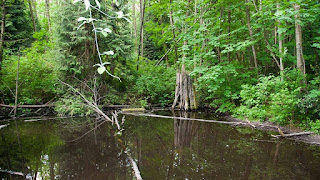CAMOSUN BOG ESSAY PR
Camosun Bog It takes thousands of years for a bog to form. It starts off with a lake and peat starts to grow off the edges of the glacial moraine. Peat is also known as dead sphagnum. Dead sphagnum does not decay, which means the sphagnum grows upon the dead sphagnum. Bogs also form sphagnum moss. The keystone species of a bog is sphagnum moss. A keystone species is what defines a bog. Sphagnum maintains the acidic conditions favoured by the bog plants. It has an unbelievable capacity to absorb water. It also pumps hydrogen ions into its environment, building a very acidic surrounding. Peat is the definition of dead sphagnum. It is a mass of partially decayed vegetarian or organic matter. Peat (dead sphagnum) will always have its structural integrity. This means even after 4000 years the sphagnum will always remain in the bog and grow upon new sphagnum mosses. Peat does not turn into soil because after growing new sphagnum there would be layers of sphagnum. ...
